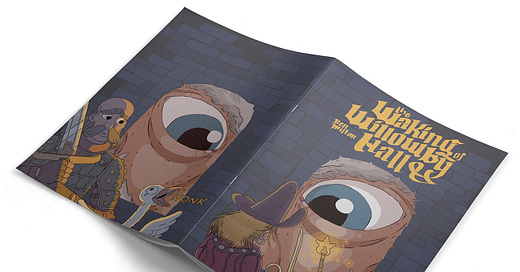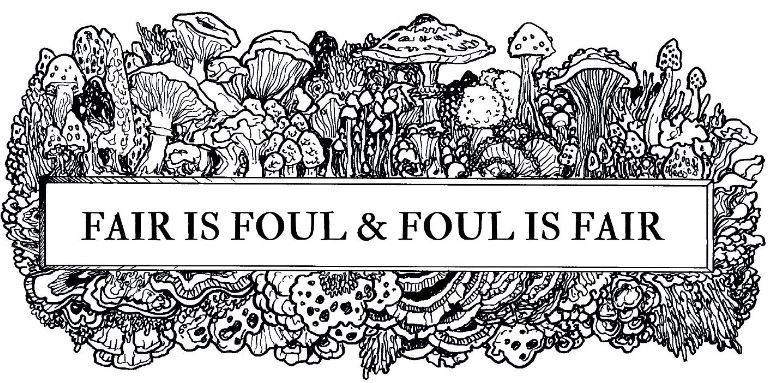Welcome to the 13th issue The Glatisant, Questing Beast’s free monthly newsletter. You can read previous issues here and help support the newsletter on Patreon here.
The Waking of Willowby Hall, my first big D&D adventure, is publicly available! You can get it in Print + PDF from the Swordfish Islands webstore, or just in PDF from DriveThruRPG and Itch.io.
The Waking of Willowby Hall is a dense, highly interactive RPG adventure set in a ruined manor beset by a rampaging giant, roving bands of restless dead, and a very angry goose.
Suitable for PCs of approximately 3rd level.
Features a highly interactive environment that rewards clever play.
Perfect for one-shots or for dropping into an existing campaign.
Contains "One Page Dungeon" maps that allow the DM to run much of the adventure at a glance.
Uses bullet points and control-panel layout for maximum ease of use.
Statted for Knave, but easily usable with any old-school fantasy RPG.
Lavishly illustrated by Sam Mameli.
Take a look inside:
Reviews
Ten Foot Pole has added three new products to its list of “The Best” RPG adventures: The Palace of Unquiet Repose, Star Spire, and The Bruja, The Beast, and The Barrow.
On The Palace of Unquiet Repose:
This, though, does a great job of conveying . . . this sense, in almost every encounter, that this place IS the legacy of a long dead empire of evil magic. The sense of dread is never very fall way. A sense of the cyclopean. Of ennui. Of forgotten things. It’s all in there
And note the writing. Lathered horses. Big dumb farm boys. Streaks of BURNING pink and a cacophony of sound. Sand cooling to crazed glass. This is good writing. The scenes spring to mind. You can immediately both imagine it … and, there are great black chunks in your imagining that your mind races to fill in.
Geek Gamers has a review/playthrough of the solo game Thousand Year Old Vampire, a book I’ve been interested in for its production values alone:
Rise Up Comus has a two part series reviewing Gradient Descent, the new space-megadungeon module for Mothership.
Reviews from R’lyeh reviews Jon Peterson’s new book of RPG history The Elusive Shift, which examines how wargames morphed into roleplaying games in the years following the release of OD&D.
The Elusive Shift is a dense and not always an easy read. As an academic work it is not necessarily a casual read, but it is a fascinating one, capturing a history that few of us remember or have access to.
Zedeck Siew and Mun Kao have a write up in Kill Screen, examining their view that writing and art are a form of game design.
The way the entries are written for encounters, for example: What does this single sentence make you imagine? How do I write this idea in a way that would get the hypothetical players imagining themselves in that situation? How do I write this sentence so that they would want to interact with this thing that’s going on? How do you make images that draw in the players to what you describe?
Tabletop roleplaying games are a conversation; how you get people into the conversation is design. How you describe a particular place or how you’ve drawn a particular character, are equally important as the mechanical rules.
Vi at Collabs Without Permission also made a “Creator Feature” about Zedeck, taking a comprehensive look at his RPG work:
And Now a Brief Word From Our Sponsors…
Inkwell Ideas recently released five new NPC Portraits Decks with over 50 characters each: Adventurers (NPCs the party can encounter), Hirelings & Henchmen, Coastal Townsfolk, Frontier Townsfolk, and Animals (familiars/companions). Each card has a color portrait on one side and the character's system neutral personality/background on the back.
Interested in hand-picked Dungeons and Dragons content? The Dungeon Gazette is a weekly newsletter featuring DM tools, character art, and articles from content creators of all kinds.
If you’d like to submit an ad for The Glatisant’s 5,700+ email subscribers, contact me at questingmaps at gmail dot com. The cost of a 50-word ad is $100. Thanks to all our advertisers for supporting this newsletter.
New and Upcoming
The third edition of Whitehack has been released! PDFs are available here, and print versions here (remember to google for Lulu coupons first).
Rise Up Comus is developing a Tarot-based dungeon crawler called His Majesty the Worm, which will focus on “often forgotten mechanics like encumbrance, light, player relationships, food, etc .”
Dreaming Dragonslayer has released a free, updated version of his Maze Rats/Hot Springs Island mashup, Island Rats.
Old-School Essentials has released three new OSE adventures: The Incandescent Grottoes (Gavin Norman), Halls of the Blood King (Diogo Noguiera), and The Isle of the Plangent Mage (Don Stroud). The Hole in the Oak and Winter’s Daughter have also been revised. Read all about it here.
Hack and Slash has released Artifices, Deceptions, and Dilemmas, a collection of tricks and traps for making your dungeons more deadly, but still fair.
No longer will your players complain about traps or unfair encounters. Now when they meet their doom, they will blame themselves for their own foolishness! Be as cruel and devious as you want with these guidelines on how to do so fairly!
Looking for something to spice up an encounter? Pick one of hundreds of options of traps, rooms, walls, tricks or more! Fill rooms with ease, design encounters in ways that give your players the freedom to put their own characters in hot water!
Theory and Advice
I’ve started a new series on Questing Beast where I solicit questions from my subscribers and patrons, and then attempt to answer them with a mini-panel of other D&D YouTubers. They have been a ton of fun so far. Check out my first episode with Seth Skorkowski and Professor Dungeon Master, or the second episode with Dael Kingsmill and The Bard (of Why HeroQuest is so Great fame).
Welcome to the Deathtrap has created something remarkably useful: a new blog dedicated to cataloging a huge number of modular OSR rules that you can hack into your home game. Each rule has been linked to the games where it originally appears, and is tagged with related themes and genres, making sorting easy.
Seed of Worlds has developed a system that applies Emmy Allen’s depthcrawl mechanics to running festivals. Part 1 explains the rules, part 2 is a play report.
Was it Likely? explains how Your System Isn’t The Game, It’s Just Another Player.
Imagine your system is another player…by this I mean, get used to thinking about your system like another player: an active participant in the game for sure, but one who, ultimately, doesn't get to run things on their own. Your system should offer input, a few good ideas, maybe some surprises, and then shut up and pass the spotlight to another player.
The next episode of Dear Gary, GG NO RE’s RPG advice column, has been released. Listen here:
Michael Prescott came up with an interesting thought experiment: the MOSAIC Strict RPG Design framework. It proposes a set of criteria for publishing short, modular rules that don’t reference mechanics in any other publication, allowing them to be bolted onto any RPG.
Philosopher Zeus makes the case for a style of play I particularly enjoy: running multiple PCs at the same time.
Justin Alexander (of The Alexandrian) has created a YouTube channel for sharing his RPG insights. Here’s one on running sandbox adventures:
Patrick Stuart writes on three features that make encounters more “sticky”: Openness (easy to interact with), Non-Neutrality (difficult to walk away from), and Consequences (significant fallout no matter what).
Spriggan’s Den has a post on writing efficient room descriptions.
Gus at All Dead Generations has an essay on “Jewelbox Dungeons.”
Industry Insights
Hasbro recently revealed a surprising fact about Wizard of the Coast:
. . . the operating profit for the WotC and Digital Gaming segment for 2020 was $420.4 million. That’s an eye-popping number on its own, representing a 46% operating profit margin, but what’s even more amazing is that the number for the WotC and Digital Gaming segment is over $112 million more than the operating profit for Hasbro’s entire consumer products segment, which includes its massive toy business and all the rest of its games.
Midwinter Minis made a video on recasting Warhammer figures and the ways that legitimizing the practice could benefit Games Workshop.
Game Content
Near the beginning of February Patrick Stuart proposed a challenge where bloggers would all use the same Dyson Logos map as the basis for a dungeon of their own design. So far 18 different dungeons have been submitted.
Against the Wicked City has a list of 72 encounters from the City of Spires (which have all actually occurred in that campaign).
Immense pit leading down to a vast, vaulted concrete chamber where immense iron serpents hang coiled on the walls, the slumbering war machines of a now-vanished civilisation. One of them is still semi-active and will attempt to repel intruders, turning its huge spotlight eyes upon them, its speakers blaring warnings in long-dead languages as it slithers forwards to attack.
Jonathan Newell at Bearded Devil has released two free, fully illustrated, 30+ page adventures for his Elfhame setting.
Bearded Devil also has a d100 table of Curios, Oddities, Tosh, and Treasure.
A glass box containing a small spider, a gnawed human finger-bone, and curious webbing spelling out the words “I always loved you.” When fed humanoid remains, the spider spins elaborate webs spelling out the last words of whoever it consumed.
Luke Gearing has a large list of D&D spells with their levels and casting mechanics replaced by rituals.
Witch Lock. One Use: Acorns from an oak grown around a key, ground to a paste and smeared on the item to be locked.
Archon’s March On has 12 Obvious Traps with Unexpected Twists.
Ceiling is covered in spikes impaling rotten corpses. Door out of room is opened by one of two buttons. Pressing the wrong button causes the spikes to retract and release the corpses, which wake up when they hit the ground. They are zombies.
That’s it for issue #13. See you all in April!







